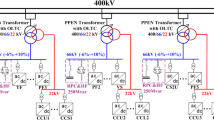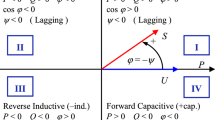Abstract
The regulating power transformers are utilized in industrial applications and electrical energy networks in on load tap changer. The technological advancements of mixed-type of load, including wind power on load tap changer (OLTC) are addressed in this work. The discussion and presentation of OLTC applications include the general switching concepts for OLTCs. However, on load tap changers of the mechanical type were used in the past, they had a number of drawbacks and restrictions, including arcing, expensive maintenance, poor response times, and other issues. Electronic or solid-state tap changers were adopted to solve these issues. A quick running OLTC regulator with solid-state component are added up as tap changer for controllability which consists of insulated gate bipolar transistor and thyristor to reduce arcing instead of mechanical switches. This work describes the development of a quick OLTC solid-state regulator, with results in MATLAB demonstrating the enhanced on load tap changing performance, which will be useful to the industrial experts and R&D professionals, since the drawback of under load tap changer of cumulative effect of change in load, voltage and the impedance effect is addressed by this novel technique to safeguard against voltage stability of the power system. The performance evaluation can be done by digital signal processing communication from remote.
Access provided by Autonomous University of Puebla. Download conference paper PDF
Similar content being viewed by others
Keywords
1 Introduction
On load tap changers (OLTC) of power transformers are a crucial component for any contemporary power system. For almost 90 years, the primary elements of electrical networks and industrial applications have been power transformers with on load tap changers (OLTCs). By continuously changing the transformer ratio under load, OLTC regulates the voltage and shift phase. The two switching principles employed for load transfer operations are resistor-type OLTC and reactor-type OLTC since the beginning of tap changer development. The mechanical OLTC regulates the voltage dips but creates contact arcs in the diverter switches while changing the taps, which creates losses during tap changing and noise disturbances. This could be arrested by the use of solid state on load tap changing method.
2 Overview of the System
The functional block diagram of OLTC transformer is shown in Fig. 1.
A transformer is an electrical tool that works by using electromagnetic induction, which means electricity is created when a conductor moves through a magnetic field. A transformer has two parts called primary and secondary windings. This is mostly about moving electricity from one place to another. It’s important to make sure the right amount of electricity goes into a transformer. Hence, usage of tapping is to make sure the voltage is steady based on how much the transformer can handle. Therefore taps are attached to different parts of the transformers coils, which changes the number of turns in the coils. There are ways to make this thing automatic by OLTC. Figure 2 shows the internal details of three-phase on load tap changer.
Figure 3 shows the on load tap changer mechanism with diverter switches.
Figure 4 shows tap position in on load tap changer.
Figure 5 shows the next position after tap change in on load tap changer.
3 Three-Phase OLTC Regulating Transformer Yg/(D1)-17 Positions
The three-phase tap-changing transformer (two windings) is used to represent a transformer with two coils that can be adjusted to change the voltage. The first step that changes the tap on the first part is that coil 1 is joined in the shape of a Y. Further, it connects winding 2 in two different ways either wye or delta.
The way the tap is set and controlled decides how much the transformer can increase or decrease its voltage level. When set the mode to tap control, the input signal controls where the tap is. When the voltage regulation mode is turned on, an internal device compares the input signal with a reference voltage and controls the position of the tap as shown in Fig. 6.
3.1 Three-Phase Mutual Inductance
In three phase, mutual inductance block helps in the setup of three-phase power systems more easily. Instead of using complicated terms, it uses simpler ones called positive and zero sequence resistances and inductances.
4 Wind Turbine and the Doubly-Fed Induction Generator System
The process of changing electricity from AC to DC and back to AC is split into two parts. The rotor and grid are converters that use power electronics to change a DC voltage into an AC voltage. A capacitor connected to the DC side works like a battery for DC power. A special tool called an inductor L is used to join grid to the grid. The rotor is connected to the grid with slip rings and brushes, while the stator is directly connected. The wind turbine turns the power from the wind into electricity, which goes into a generator. The generator then sends the electricity to the power grid. The control system monitors the convertor rotor and grid how to move by sending signals called pitch angle and voltage commands as shown in Fig. 7.
6 Smooth Variation of Voltage
Phasor simulation of on load tap changer (OLTC) regulating transformer gives smooth variation of transformer taps 1 and 2, voltage in per unit B1, B2 and B4, reactive power Mvar B1, B3 and real power MW B1, B3. The results obtained by this new technique which are shown in Fig. 9 address the variation of three-phase smooth voltage by introducing positive and zero sequence resistances and inductances.
7 Analog to Digital Signal with PCM
On line performance monitoring from remote through digital communication system of on load tap changer process is as shown in Figs. 2 and 3.
The steps in conversion of analog to digital signal goes through filtration to limit bandwidth and thereafter PCM encoder consisting of sampling, quantizing and encoding. The elements of PCM system are transmitter, transmission path and receiver as shown in Fig. 10.
8 Results
In a radial transmission line connected through the transformer and if the load is being increased gradually. The action of the under load tap changer (ULTC) is to maintain the voltage at load terminal by changing the transformation ratio N1/N2, when applied voltage is same; however, when the load impedance is reflected on primary side of the transformer the input impedance gets reduced and it further reduces the voltage, and in turn, ULTC tries to increase the voltage which is cumulative phenomena results into voltage stability situation.
9 Conclusion
The performance result indicates that the on load tap changer operates satisfactorily during the load including wind energy, without causing sparking in the diverter chamber and thus protecting the transformer from fire hazards. Also the results indicate the input impedance effect reduction due to change of load has little effect on the performance of on load tap changer due to the introduction of positive and zero sequence resistances and inductances. The performance evaluation can be done from remote by digital communication technique.
References
Faiz J, Siahkolah B (2003) New solid state on load tap changers technology for distribution transformer. IEEE Trans Power Deliv 18(1):136–141
Mailah NF, Bashi SM, Meng WH (2003) Microcontroller based semiconductor tap changer for power transformer. In: IEEE Bologna Power Tech Conference. Bologna, Italy, pp 1–6
Noorbakhshi’ M, Afzalian A (2007) Design and PLC based implementation of supervisory control for under-load tap changing transformer. In: International conference on control, automation and system, Seoul, Korea, pp 901–906
Sarkar M, Subudhi B, Daigavane P (2019) Robust PI damping controller design using wide-area signal for inter-area oscillation in power system. In: 2019 8th international conference on power systems (ICPS). IEEE, pp 1–6
Faiz J, Siahkolah B (2007) New controller for an electronic tap changer-Part II: measurement algorithm and test results. IEEE Power Deliv 22(1)
Echavarria R, Claudio A, Cotorogea M (2007) Analysis, design, and implementation of a fast on load tap changing regulators. IEEE Power Electron 22(2)
Shanqi H (2016) Research and application of contactless load automatic voltage regulating distribution transformer. China Electr Power (TechnologyEdition) 1:53–55
Chaudhari M, Babu K, Khubalkar SW, Daigavane P (2019) Off-grid hybrid solar power conditioning unit for critical and non-critical loads. In: 2019 international conference on intelligent computing and control systems (ICCS). IEEE
Faiz J, Kolah B (2006) Differences between conventional and electronic tap-changers and modifications of controller. IEEE Trans Power Deliv
Mailah NF, Bashi SM, Meng WH (2003) Microcontroller based semiconductor tap changer for power transformer. In: Paper accepted for presentation at 2003 IEEE Bologna power tech conference, Bologna, Italy
Monroy-Berjillos D, Gomez-Exposito A (2007) Improving the voltage regulation of secondary feeder by applying solid state tap-changer to MV/LV transformers. In: 9th international conference. Electrical power quality and utilization. Barcelona
Ding T, Bo R, Bie Z, Wang X (2017) Optimal selection of phase shifting transformer adjustment in optimal power flow. IEEE Transaction 2017
Verboomen J, Herten DV, Kling WL, Belmans R (2005) Phase shifting transformers: principles and applications. In: International conference on future power system
Tirupathi R et al (2022) Application of phase shifting transformer in Indian power system. Int J Comput Electr Eng 4(2) (April 2012, computing, communication and networking 23–25 Dec 2022)
Shaikh RAJ, Naidu H, Kokate PA (2021) Evolutionary computing and mobile sustainable networks: proceedings of ICECMSN 2020. Evolutionary computing and mobile sustainable networks. Springer, Singapore
Tembhare M, Naidu H, Kokate P (2020) A review study on the multiple and useful application of fiber optic illumination system. IEEE
Katole DN, Daigavane MB, Gawande SP, Daigavane PM (2018) Improved single phase instantaneous pq theory for DVR compensating nonlinear load. In: 2018 IEEE international conference on power electronics, drives and energy systems (PEDES). IEEE, pp 1–6
Ramtekkar P, Naidu H, Dudhe S (2021) A novel wireless fire containment and extinguishing system to save life and destruction of property IEEE. In: 2021 international conference on computational intelligence and computing applications (ICCICA)
Sheikh SA, Naidu HK (2021) Train accident prevention using fuzzy logic based MEMS system, IEEE. In: 2021 5th international conference on electrical, electronics, communication, computer technologies and optimization techniques (ICEECCOT)
Lanjewar A, Khubalkar SW, Junghare AS (2018) Comparative analysis of two loop integer and fractional order PID controller for inverted pendulum. ICSEDPS 2018, GHRCE, Nagpur
Sao S, Dudhe S, Naidu H (2022) A novel IoT based sample collection method for baby meconium aspiration syndrome and analyzing suction pressure of the system, IEEE. In: 2022 10th international conference on emerging trends in engineering and technology—signal and information processing (ICETET-SIP-22)
Jagyasi DM, Naidu HK (2022) A review of MVDC circuit breaker sub-station supply for electrical traction vehicle. In: 2022 10th international conference on emerging trends in engineering and technology—signal and information processing (ICETET-SIP-22). IEEE
Kapse SSS, Daigavane MB, Daigavane PM (2020) Optimal localization and sizing of UPFC to solve the reactive power dispatch problem under unbalanced conditions. IETE J Res 66(3):396–413
Wath AK, Daigavane PM, Naidu HK (2022) A technique of image and fuzzy logic to solve traffic congesion at signal. In: IEEE 2023. Published in 2022 international conference on smart generation computing, communication and networking 23–25 Dec 2022
Author information
Authors and Affiliations
Corresponding author
Editor information
Editors and Affiliations
Rights and permissions
Copyright information
© 2024 The Author(s), under exclusive license to Springer Nature Singapore Pte Ltd.
About this paper
Cite this paper
Virkhare, R.M., Daigavane, P., Kumar Naidu, H. (2024). A Communication Technique to Improve the Performance of On Load Tap Changer of Transformer with Renewable Load. In: Shaw, R.N., Siano, P., Makhilef, S., Ghosh, A., Shimi, S.L. (eds) Innovations in Electrical and Electronic Engineering. ICEEE 2023. Lecture Notes in Electrical Engineering, vol 1109. Springer, Singapore. https://doi.org/10.1007/978-981-99-8289-9_14
Download citation
DOI: https://doi.org/10.1007/978-981-99-8289-9_14
Published:
Publisher Name: Springer, Singapore
Print ISBN: 978-981-99-8288-2
Online ISBN: 978-981-99-8289-9
eBook Packages: EnergyEnergy (R0)














